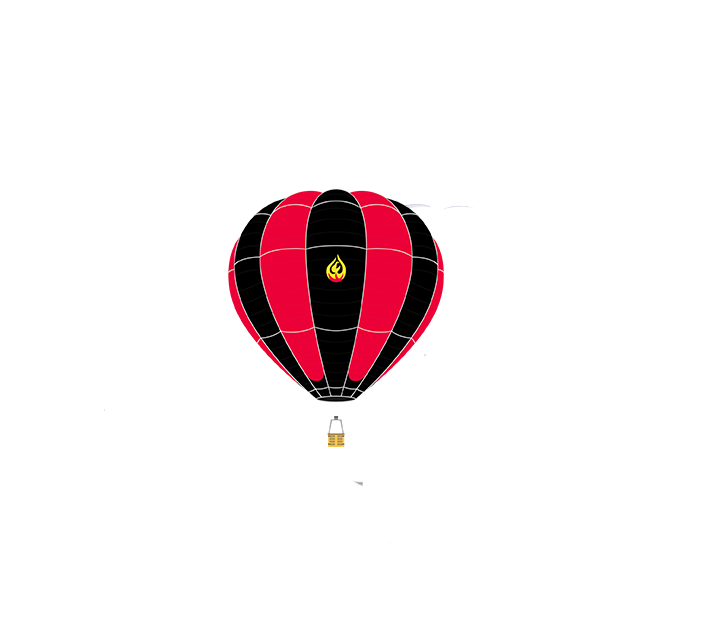Your Questions About the America’s Challenge Race for Gas Balloons Answered
The America’s Challenge is one of two distance races for gas balloons in the world. The other is the Coupe Aéronatique Gordon Bennett, the world’s oldest air race, founded in 1906. The America’s Challenge was founded by the Albuquerque International Balloon Fiesta in 1995 to provide a consistent American venue for gas ballooning. The results of the America's Challenge event are used as a qualifer for US teams to enter the Gordon Bennett.
It’s simple: the winner is the team that flies the greatest distance (measured in Great Circle distance) from the launch point, Balloon Fiesta Park in Albuquerque, while competing within the event rules.
A trophy and lots of attaboys (or girls) and bragging rights. There is no prize money associated with winning the America’s Challenge.
That record is held by the late Richard Abruzzo, who won the race five times with four different co-pilots. Peter Cuneo and Barbara Fricke have won four times. Andy Cayton has three wins, all with different co-pilots. Mark Sullivan and Cheri White, and David and Alan Levin, have won twice.
There have been five female America’s Challenge winners: Barbara Fricke, Cheri White, Janet Folkes, Tami Stevenson (Bradley) and Carol Rymer Davis.
Five international teams have won: Janet Folkes from Great Britain, flying with American co-pilot Bill Arras in 2005, David Hempleman-Adams of Great Britain and Jon Mason of Australia in 2011, Anulfo Gonzalez and Angel Aguirre of Spain in 2014, Nicolas Tieche and Laurent Sciboz of Switzerland in 2017 and Andy Cayton from the US flying with Krzysztof Zapart from Poland in 2019.
Gas balloons use a lighter-than-air gas, such as hydrogen or helium, to provide lift. The most commonly-used gas now is hydrogen, the lightest of the gases. Helium, which until recently was the gas of choice in the United States due to its stability, has become prohibitively expensive and scarce.
By contrast, hot air balloons, which are far more common, use heated air to create lift – as you’ll remember from school, hot air is lighter than cold air.
The lifting gas (hydrogen) is contained in an envelope (the “balloon” part of the balloon) that is built out of heavy, non-porous, conductive fabric. However, as the gas expands and contracts with the normal heating and cooling cycles during the day, some hydrogen is lost. To maintain altitude, the pilot must then get rid of weight. So gas balloons carry expendable weight, referred to as “ballast,” usually in the form of sand which is carried in bags hung on the side of the basket or water carried in gallon jugs.
Since ballast is essential for maneuvering and especially landing, there are essentially two “consumables” that affect the amount of time a gas balloon can stay aloft and – indirectly – the distance it can travel: gas and ballast. The pilots that do the best job of conserving both often are in the best position to win a race like the America’s Challenge.
This is obviously a very complicated question to answer, but in the simplest terms, to go up you get rid of weight by dropping sand or water ballast (or anything else that has weight, if you’re desperate enough). To come down, you “valve” gas by pulling a rope in the basket that opens a panel in the top of the balloon to release hydrogen. Pilots can also take advantage of the natural expansion of gas due to solar heating after sunrise to go up, and the contraction of gas as the air cools around sunset to come down. Needless to say, pilots try to valve and ballast as little as possible, since gas and sand in a gas balloon are the equivalent of fuel in a car and the pilots can’t stop at the gas station to get any more!
White is the color that keeps the balloon the most stable in that the reflectivity lessens the impacts of solar heating and cooling on the gas inside the envelope, helping to minimize loss of gas throughout the flight and maximize flight time.
The maximum size for balloons competing in the America’s Challenge is 1,000 cubic meters (about 37,000 cu. ft.). Smaller balloons can participate, as has been the case with the Aero Club of America’s 24,000 cu. ft. balloon, but smaller balloons are at a disadvantage in a distance race.
They don’t. Once the balloon takes off, the pilots have at their disposal only the gas, ballast, instruments, and supplies (food, water, clothing, etc.) that they carry on board.
It depends on the winds and weather, but America’s Challenge competitors have flown some of the longest gas balloon flights in history for 1,000 cu. meter balloons. The epic 2017 America’s Challenge race rewrote the competition gas ballooning record book: the top two teams exceeded not only the old America’s Challenge race record, but also the longest distance ever flown in the Coupe Gordon Bennett. The Swiss team of Nicolas Tièche and Laurent Sciboz flew to Labrador City in Newfoundland, Canada, travelling flew 2,281 miles (3,670 km). The second-place team of Krzysztof Zapart of Poland and two-time America’s Challenge champion Andy Cayton of the US also beat both distance marks with a flight of 2,191 miles (3,526 km) to Amqui, Quebec, near the border of Quebec and New Brunswick, Canada.
The duration record for the America’s Challenge of 70 hours 51 minutes was set in 2011 by David Hempleman-Adams of Great Britain and Jon Mason of Australia (mixed-nationality teams are allowed in the America’s Challenge). Flights of 60 hours are not unusual. However, the world duration record for 1,000 cubic meter balloons is an astounding 92+ hours, set by Germany’s Wilhelm Eimers (a frequent America’s Challenge competitor) in the 1995 Coupe Gordon Bennett.
It isn’t cheap. Depending on the manufacturer and the size, new gas balloon systems can cost in the upper five figures. A hydrogen “fill” in the U.S. for a balloon the size of those flown in the America’s Challenge can cost about $1,200 for a single (albeit multi-day) flight; in parts of Europe the cost for hydrogen is much less. Then there is all the associated equipment, a chase vehicle, and expenses for pilots and chase crew.
Yes they do, since as is the case with hot air balloons they rarely return to the launch point. The difference with a gas flight is that the balloon often travels many hundreds of miles, and while the balloon flies in a straight line and moves 24 hours a day, the roads don’t go in a straight line and the crew has to rest occasionally. Gas chases can be real adventures and require a lot of stamina (the chase crew for 2013 winners Cuneo and Fricke drove from Albuquerque to, and completely around, Lake Superior).
Each balloon has a crew of two, a pilot and a co-pilot. Although the titles might suggest otherwise, in practice on most teams the pilots fully share the responsibilities of the flight and are often equally skilled.
While ballooning has connotations of floating leisurely above the landscape admiring the view – and indeed there’s some of that and pilots wax poetically about it – the teams are actually quite busy flying the balloon, navigating, talking to air traffic controllers, and planning the next steps in their flight. They sleep in shifts, with one pilot awake while the other sleeps. They’re confined in a very small space for three days of what one pilot drolly terms “aerial camping.” Almost all the teams say that since they are on oxygen and not moving around much, they are seldom hungry. They carry nutritious and easy to eat foods as well as comfort foods to entice them to eat, and also have to remind themselves to drink fluids so they don’t become dehydrated. Most teams admit the hardest part of competing in a distance balloon race is being cooped up in such a confined space with another person for up to three days.
Space pilots and balloon pilots travel at vastly different speeds, but both will tell you the same thing: the most frequently-asked question is “how do you go to the bathroom up there?” Resisting the temptation to say, “the same way you do down here,” the teams tell us they carry a bucket or other porta-potty type conveyance to facilitate their daily business – and they try to keep that business to a minimum.
In addition to chase crews, individual teams may have a “brain trust” of individuals that monitor weather conditions and help the pilots plan strategy. Many teams employ meteorologists to analyze the weather and advise them on the best altitudes to fly to find the right winds and on avoiding bad weather. Some consult with other pilots on the ground to help them plan strategy.
The America’s Challenge Command Center is staffed 24 hours a day while the race is in progress. Its highly trained teams of controllers – at least two are on duty at all times – assist the pilots with coordination with air traffic controllers across the country, provide basic weather information, help chase crews with locating their pilots and the best routes to reach them, and if necessary call in law enforcement and search and rescue personnel at landing sites. The volunteer staff also includes a scoring team which analyzes the results of the race and determines the final results, a hospitality team, and a media liaison. Just about the only thing the Command Center doesn’t do is provide strategic advice or strategic information about other teams.




 News
News Schedule
Schedule Tickets
Tickets Maps
Maps Store
Store Guide
Guide


